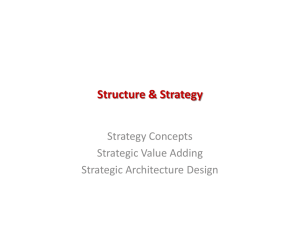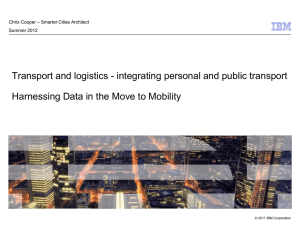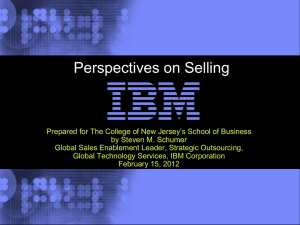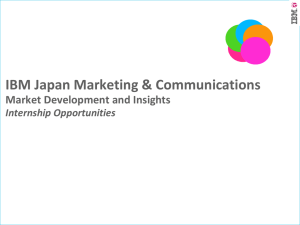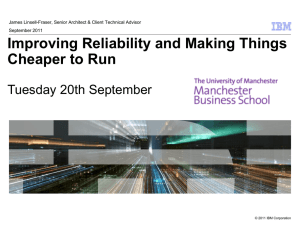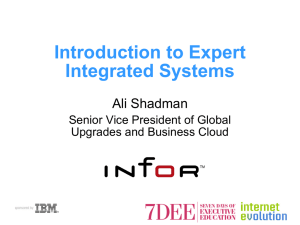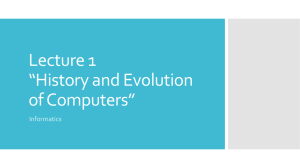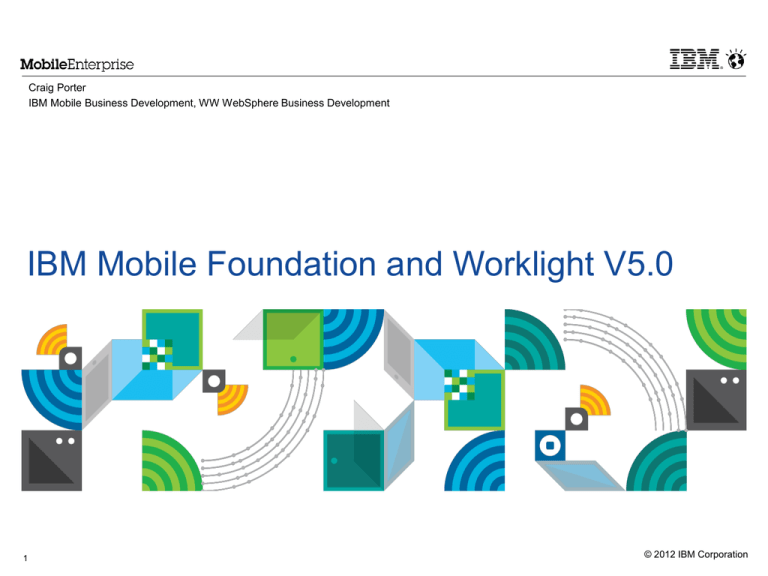
Craig Porter
IBM Mobile Business Development, WW WebSphere Business Development
IBM Mobile Foundation and Worklight V5.0
1
© 2012 IBM Corporation
Mobile is a mandatory transformation
10 Billion
61%
45%
devices
by 2020
of CIOs put
mobile as priority
increased productivity
with mobile apps
2
© 2012 IBM Corporation
Mobile applications deliver tremendous benefits
Business to Enterprise
• Increase worker productivity
• Improve claims processing
• Increase revenue through sales
engagements
• Extend existing applications to
mobile workers and customers
• Increase employee
responsiveness and decision
making speed
• Resolve internal issues faster
• Reduce cost by utilizing
personal owned instead of
corporate owned devices
Business to Consumer
• Improve customer satisfaction
• Deeper customer engagement
and loyalty
• Drive increased sales through
personalized offers
• Customer service
• Competitive differentiator
• Improve brand perception
• Deeper insight into customer
buying behavior for up sell and
cross sell
• Improve in store experience
with mobile concierge services
© 2012 IBM Corporation
But also with some unique challenges
How do you quickly:
Engage with anyone, customers, partners
or employees, no matter who owns the
device
Extend to anything, from instrumented
machines to a broad spectrum of smart
devices
Execute business anywhere, with
ubiquitous, trusted and secure transactions
Top Mobile Adoption Concerns:
1. Security/privacy (53%)
2. Cost of developing for multiple
mobile platforms (52%)
3. Integrating cloud services to
mobile devices (51%)
Source: 2011 IBM Tech Trends Report
https://www.ibm.com/developerworks/mydeveloperworks/blogs/techtrend
s/entry/home?lang=en
200 Million
employees BYOD
(bring your own devices)
© 2012 IBM Corporation
How is IBM’s Mobile Approach Different?
Bridging the gap between platform and app providers
Platforms
Vodafone
• Networks
• Devices
• OS’s
Apps
Business
strategy and
planning
Process &
transaction integrity
• Smarter Commerce
• Social Business
• BI & Analytics
• Etc.
Full lifecycle solutions
Open cross-platform
development
End-to-end security and
management
Integration with backend systems,
enterprise data and cloud
Open n Governed n Integral
IBM Mobile Enterprise
5
© 2012 IBM Corporation
IBM Mobile Strategy Addresses Challenges
Extend & Transform
Build & Connect
Extend existing business
capabilities to mobile devices
Build mobile applications
Connect to, and run backend
systems in support of mobile
Transform the business by
creating new opportunities
Key Capabilities
• Mobile web, hybrid and native app
development
• Enterprise data, service, and
application integration at scale
• Enterprise wireless networking
Key Capabilities
• Analytics incorporating context and
location from mobile devices
• Commerce and collaboration as key
components of mobile-enabled
solutions
• Strategy, planning, implementation
Manage & Secure
Manage mobile devices, services
and applications
Secure my mobile business
6
Key Capabilities
• Mobile lifecycle management
• Device analytics and control
• Secure network communications & management
© 2012 IBM Corporation
Sample Clients
Extend & Transform
Build & Connect
Extend existing business
capabilities to mobile devices
Build mobile applications
Connect to, and run backend
systems in support of mobile
Transform the business by
creating new opportunities
Manage & Secure
Manage mobile devices, services
and applications
Secure my mobile business
© 2012 IBM Corporation
Extend & Transform
IBM Mobile Enterprise
Build & Connect
Manage & Secure
Challenges with Implementing Mobile
How do I accommodate all the
different mobile platforms?
• Highly fragmented set of …
• Platforms and devices
• Languages, APIs, and tools
• Native programming models not
portable across platforms
I need to develop different apps for
different departments – quickly.
8
How do I design and develop a
high-quality User Experience?
• High quality user experience is
a requirement
• Quality influenced as much by
design as it is by function
I need to connect my apps to
existing systems
• Higher frequency of releases
and updates
• Existing services typically need
to be adapted for mobile
• Added pressure on teams to
deliver on time and with
quality
• Enterprise wireless networks
are running out of bandwidth
for employee devices
© 2012 IBM Corporation
Extend & Transform
IBM Mobile Enterprise
Build & Connect
Manage & Secure
IBM’s Mobile Foundation Addresses the Challenges
Mobile Enterprise Application Platform
Includes
IBM Mobile
Foundation
Build - Connect - Run
• IBM Worklight
• IBM WebSphere Cast Iron
• IBM Endpoint Manager for
Mobile Devices
Plus New Services Offering
• IBM Software Services for
Mobile Foundation
9
© 2012 IBM Corporation
Extend & Transform
IBM Mobile Enterprise
Build & Connect
Manage & Secure
Delivering for multiple mobile platforms
• Enterprise back-end connectivity
• Third-party integration
• Strong authentication framework
• Encrypted offline availability
• Data collection for analytics
• Packaged runtime skins
Open, cost-effective, cross-platform app development
App development using
native and/or familiar web
technologies:
• HTML5
• CSS3
• JavaScript
10
App delivery in variety
of forms:
• Mobile Web app
• Hybrid app
• Native
Compatible with prominent
HTML5 libraries and tools:
© 2012 IBM Corporation
Extend & Transform
IBM Mobile Enterprise
Build & Connect
Manage & Secure
Mobile strategies also extend across channels
Needed
Capabilities
Why?
Multichannel Sites
and Applications
Mobile Applications
(native and hybrid)
Provide a consistent integrated
web experience across multiple
channels (desktop browser,
smartphones, tablets, etc.)
Provide an experience that
takes full advantage of the
device and its ecosystem
Aggregate multiple
applications
Content management
Personalized for roles
Dedicated, task focused app
Integrates with device
capabilities
App store presence
Where are you starting today?
11
© 2012 IBM Corporation
1
2
Extend & Transform
Build & Connect
Manage & Secure
Rapid, simple & flexible connectivity for mobile apps
WebSphere Cast Iron Cloud integration
Simple and flexible integration for all connectivity projects, allowing you to rapidly
integrate SaaS and back-end systems with mobile apps
Client Challenge
Simplified and cost effective mobile
integration to back-end systems and cloud
Key Capabilities
• Native connectors and template
integration processes (TIP’s) to connect
mobile apps to backend & cloud systems,
reducing project costs up to 80%
• Bidirectional connectivity and business
logic to increase data quality and
streamline business processes
• Centralized monitoring
• Simple and flexible, user-friendly, wizardbased, “configuration, not coding”
architecture provides best-practices and
repeatable mobile integration
12
© 2012 IBM Corporation
Extend & Transform
Build & Connect
Manage & Secure
Device Lifecycle, Data Protection
IBM Endpoint Manager for Mobile Devices
A highly-scalable, unified solution that delivers device management and security
across device types and operating systems for superior visibility and control.
Client Challenge
Managed = Secure
Systems
management
Common agent
Unified console
Common
infrastructure
Single server
Key Capabilities
Security
management
13
Mobile
endpoint
• A unified systems and security management
solution for all enterprise devices
• Near-instant deployment of new features and
reports to customer’s environments
IBM Endpoint Manager
Desktop / laptop /
server endpoint
Managing and securing enterprise and BYOD
mobile devices without additional resources.
Purpose-specific
endpoint
• Platform to extend integrations with Service
Desk, CMDB, SIEM, and other informationgathering systems to mobile devices
• Advanced mobile device management
capabilities for iOS, Android, Symbian, and
Windows Mobile, Windows Phone
• Security threat detection and automated
remediation
© 2012 IBM Corporation
Extend & Transform
IBM Mobile Enterprise
Build & Connect
Manage & Secure
A successful mobile strategy considers …
And provides …
What is the
Business Vision
for Mobile?
Strategic direction for mobile
capabilities that considers audience
needs, business priority, and IT
readiness
Strategic direction on device support
What is the
Current Mobile
Business
Situation?
Which Capabilities
can close the Gap?
Strategic direction on build approach
based on technical experience and
time to market priorities
Strategic direction on options for
operation of the mobile solution
Which Capabilities
offer highest value
Success of the strategy depends upon a
core team of client and IBM resources
that collaboratively builds the strategy
Your business goals and audience goals are aligned to your IT capabilities to
create a practical roadmap for mobilization
14
© 2012 IBM Corporation
IBM Mobile Enterprise
Evaluate IBM Worklight for Free..
Get prepared. Integration of mobile, social platforms with existing business applications will
be a high-demand skill set.
http://www.ibm.com/developerworks/downloads/#websphere
???
15
Contact your OpenLogix Rep for more
information on IBM Mobile Enterprise strategy
© 2012 IBM Corporation
Thank You
• Learn more at:
www.ibm.com/mobile-enterprise
• Access white papers and webcasts
• Get product and services information
• Download and begin using IBM
Endpoint Manager
© 2012 IBM Corporation
Legal Disclaimer
• © IBM Corporation 2012. All Rights Reserved.
• The information contained in this publication is provided for informational purposes only. While efforts were made to verify the completeness and accuracy of the information contained
in this publication, it is provided AS IS without warranty of any kind, express or implied. In addition, this information is based on IBM’s current product plans and strategy, which are
subject to change by IBM without notice. IBM shall not be responsible for any damages arising out of the use of, or otherwise related to, this publication or any other materials. Nothing
contained in this publication is intended to, nor shall have the effect of, creating any warranties or representations from IBM or its suppliers or licensors, or altering the terms and
conditions of the applicable license agreement governing the use of IBM software.
• References in this presentation to IBM products, programs, or services do not imply that they will be available in all countries in which IBM operates. Product release dates and/or
capabilities referenced in this presentation may change at any time at IBM’s sole discretion based on market opportunities or other factors, and are not intended to be a commitment to
future product or feature availability in any way. Nothing contained in these materials is intended to, nor shall have the effect of, stating or implying that any activities undertaken by
you will result in any specific sales, revenue growth or other results.
• If the text contains performance statistics or references to benchmarks, insert the following language; otherwise delete:
Performance is based on measurements and projections using standard IBM benchmarks in a controlled environment. The actual throughput or performance that any user will
experience will vary depending upon many factors, including considerations such as the amount of multiprogramming in the user's job stream, the I/O configuration, the storage
configuration, and the workload processed. Therefore, no assurance can be given that an individual user will achieve results similar to those stated here.
• If the text includes any customer examples, please confirm we have prior written approval from such customer and insert the following language; otherwise delete:
All customer examples described are presented as illustrations of how those customers have used IBM products and the results they may have achieved. Actual environmental costs
and performance characteristics may vary by customer.
• Please review text for proper trademark attribution of IBM products. At first use, each product name must be the full name and include appropriate trademark symbols (e.g., IBM
Lotus® Sametime® Unyte™). Subsequent references can drop “IBM” but should include the proper branding (e.g., Lotus Sametime Gateway, or WebSphere Application Server).
Please refer to http://www.ibm.com/legal/copytrade.shtml for guidance on which trademarks require the ® or ™ symbol. Do not use abbreviations for IBM product names in your
presentation. All product names must be used as adjectives rather than nouns. Please list all of the trademarks that you use in your presentation as follows; delete any not included in
your presentation. IBM, the IBM logo, Lotus, Lotus Notes, Notes, Domino, Quickr, Sametime, WebSphere, UC2, PartnerWorld and Lotusphere are trademarks of International
Business Machines Corporation in the United States, other countries, or both. Unyte is a trademark of WebDialogs, Inc., in the United States, other countries, or both.
• If you reference Adobe® in the text, please mark the first use and include the following; otherwise delete:
Adobe, the Adobe logo, PostScript, and the PostScript logo are either registered trademarks or trademarks of Adobe Systems Incorporated in the United States, and/or other
countries.
• If you reference Java™ in the text, please mark the first use and include the following; otherwise delete:
Java and all Java-based trademarks are trademarks of Sun Microsystems, Inc. in the United States, other countries, or both.
• If you reference Microsoft® and/or Windows® in the text, please mark the first use and include the following, as applicable; otherwise delete:
Microsoft and Windows are trademarks of Microsoft Corporation in the United States, other countries, or both.
• If you reference Intel® and/or any of the following Intel products in the text, please mark the first use and include those that you use as follows; otherwise delete:
Intel, Intel Centrino, Celeron, Intel Xeon, Intel SpeedStep, Itanium, and Pentium are trademarks or registered trademarks of Intel Corporation or its subsidiaries in the United States
and other countries.
• If you reference UNIX® in the text, please mark the first use and include the following; otherwise delete:
UNIX is a registered trademark of The Open Group in the United States and other countries.
• If you reference Linux® in your presentation, please mark the first use and include the following; otherwise delete:
Linux is a registered trademark of Linus Torvalds in the United States, other countries, or both. Other company, product, or service names may be trademarks or service marks of
others.
• If the text/graphics include screenshots, no actual IBM employee names may be used (even your own), if your screenshots include fictitious company names (e.g., Renovations, Zeta
Bank, Acme) please update and insert the following; otherwise delete: All references to [insert fictitious company name] refer to a fictitious company and are used for illustration
purposes only.
© 2012 IBM Corporation


